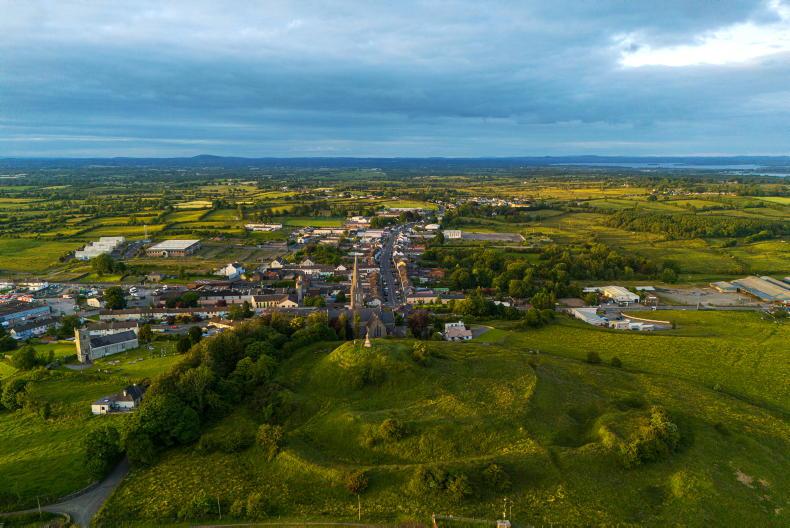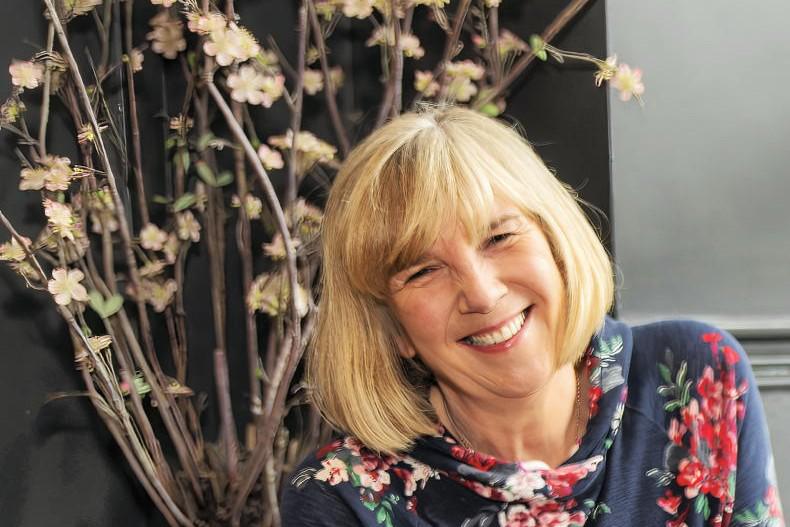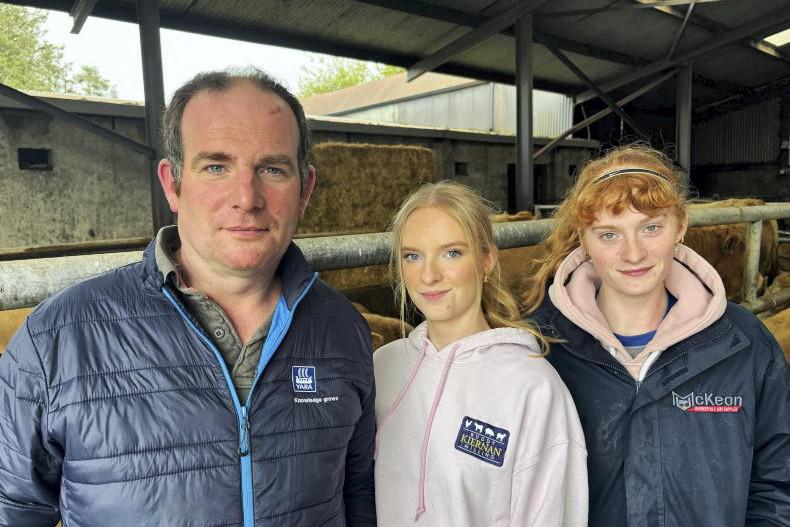It’s a rare bright and sunny summer day, and here we are throwing down the gauntlet in Co Longford.
Little did Irish Country Living know the origins of the phrase – which is still used in political and sports commentary – dates back to the Normans, whose fascinating story is told in a little gem of a visitor attraction in Granard. The gauntlet is essentially a chainmail glove that a knight might wear. If you were taking on another knight in a duel, you’d throw it down as a challenge to your rival.
It’s just one of the fascinating facts a visitor learns at the Knights and Conquests Heritage Centre, which sits in the shadow of Ireland’s tallest motte and bailey, at 534 feet high. The fortification, which is essentially a high mound, was built on a pre-existing height.
Granard is thought to originate from ‘An Grian Ard’ meaning this height upon which the sun was worshipped. It was the name given to the beacon hill and gathering place on which a great fire was lit in pagan times at Bealtaine, or mid-summer, similar to nearby Uisneach in Co Westmeath.
Having walked through the buttercups to the top of the hill, you can see why it was a focal point. There are spectacular panoramic views of nine counties in three different provinces and five lakes across rolling green countryside.
The hill was also an inauguration site for the O’Farrells in Longford. St Patrick came there too, leaving his foster brother Guasacht to establish a church nearby.
Community project
This is very much a project of the people, explains manager Déirdre Orme. “This (centre) is a community social enterprise project. These three buildings had fallen into NAMA and people got together and fundraised to have the heritage centre and café together.”
Given that the motte was the work of the Normans, who were feared fighters descended from the Vikings who settled in Normandy, it was decided that this lesser-known part of our heritage would be showcased. Many placenames and surnames in Ireland come from Norman times.

Déirdre Orme, manager of Knights and Conquest Heritage Centre.
“Our centre makes it interactive and interesting for visitors and groups,” says Déirdre, who is clad in typical Norman attire during the tour. She invites visitors, particularly children, to get into the spirit and dress in the costumes as they enjoy the tour, meander around the exhibits, and get to grips with the Norman weaponry and armour.
Invited to sit on an impressive throne, which was a prop from the Vikings TV series, Déirdre tells us she was actually an extra in the sixth series of the hit show. She says it was “amazing” to step into a different world, and the centre gives the public a similar taste of that.
History lesson
After conquering England in 1066, the Normans landed in Wexford in 1169 at the behest of the ousted King of Leinster, Diarmuid McMurrough. They later arrived in Longford in 1172, where they defeated the O’Farrells, and the Norman Lord Richard de Tuite built a wooden castle on the motte.
Through the use of impressive video, audio-visual aids, an archaeology room, and props, each visitor learns about the fascinating history of the conquest and way of life of the Normans – their battle dress, weapons, their language, and, most importantly, their legacy in modern Ireland.
There’s even an opportunity to try on the fearsome fighter’s chainmail or armour worn in battle, which weighs an astonishing 12kg.
“Feel the weight of it, look at the intricate design. Imagine being tasked with having to make that,” says Déirdre. “They were highly skilled craftsmen, and great blacksmiths around that time.”
Trying to lift a single-handed sword, supposed to be the lightest one, is no easy task either. Déirdre points to one known as the blood liner or blood gutter – for obvious reasons.
“The knight would be completely weighed down with the chainmail, the sword, the shield, and the helmet. And then he’d be hopping up on a horse, so it was a lot to contend with,” she says, smiling.
Travelling through time, visitors also find out what Granard would have looked like in Norman times via an interactive model.
“The castle of Richard de Tuite and his lady would have been at the top of the hill. It would have been quite a fine abode,” says Déirdre, who is from Multyfarnham in Co Westmeath. “The bailey here in Granard probably had a variety of buildings – a barracks, stables, a blacksmith, the baker, all that you would expect. It’s a kidney shape to fit against the circular motte,” she adds.
The experience then swiftly moves through from invader times to revolutionary times, recalling that the motte was the site of a major battle in 1798 and its links with the sad love story of Granard native Kitty Kiernan and Michael Collins.

The spectacular view from the top of Ireland’s tallest motte and bailey, at 534 feet high, in Granard, Co Longford.
Granard Motte Community Enterprise CLG has exciting plans to expand this experience, according to Déirdre who says an additional 15 acres have been purchased to develop a living heritage park and a banqueting hall.
The idea is to have “re-enactors there so you can see the blacksmith at work, meet the characters of the day, the baker, the potter, the candlestick maker, the herbalist,” and recreate the “hum and lively nature of this burgess or bailey area, the smells and the touch, and actually just live it.”
This will bring history to life, predicts Déirdre, who is hopeful of progress over the next year on what will be a “gamechanger” tourist attraction for the area.
In the meantime, she is looking forward to the Suntown Festival from 5 July to 7 July, which includes a fire ceremony on the hill, music literature and mindfulness events.
It’s a rare bright and sunny summer day, and here we are throwing down the gauntlet in Co Longford.
Little did Irish Country Living know the origins of the phrase – which is still used in political and sports commentary – dates back to the Normans, whose fascinating story is told in a little gem of a visitor attraction in Granard. The gauntlet is essentially a chainmail glove that a knight might wear. If you were taking on another knight in a duel, you’d throw it down as a challenge to your rival.
It’s just one of the fascinating facts a visitor learns at the Knights and Conquests Heritage Centre, which sits in the shadow of Ireland’s tallest motte and bailey, at 534 feet high. The fortification, which is essentially a high mound, was built on a pre-existing height.
Granard is thought to originate from ‘An Grian Ard’ meaning this height upon which the sun was worshipped. It was the name given to the beacon hill and gathering place on which a great fire was lit in pagan times at Bealtaine, or mid-summer, similar to nearby Uisneach in Co Westmeath.
Having walked through the buttercups to the top of the hill, you can see why it was a focal point. There are spectacular panoramic views of nine counties in three different provinces and five lakes across rolling green countryside.
The hill was also an inauguration site for the O’Farrells in Longford. St Patrick came there too, leaving his foster brother Guasacht to establish a church nearby.
Community project
This is very much a project of the people, explains manager Déirdre Orme. “This (centre) is a community social enterprise project. These three buildings had fallen into NAMA and people got together and fundraised to have the heritage centre and café together.”
Given that the motte was the work of the Normans, who were feared fighters descended from the Vikings who settled in Normandy, it was decided that this lesser-known part of our heritage would be showcased. Many placenames and surnames in Ireland come from Norman times.

Déirdre Orme, manager of Knights and Conquest Heritage Centre.
“Our centre makes it interactive and interesting for visitors and groups,” says Déirdre, who is clad in typical Norman attire during the tour. She invites visitors, particularly children, to get into the spirit and dress in the costumes as they enjoy the tour, meander around the exhibits, and get to grips with the Norman weaponry and armour.
Invited to sit on an impressive throne, which was a prop from the Vikings TV series, Déirdre tells us she was actually an extra in the sixth series of the hit show. She says it was “amazing” to step into a different world, and the centre gives the public a similar taste of that.
History lesson
After conquering England in 1066, the Normans landed in Wexford in 1169 at the behest of the ousted King of Leinster, Diarmuid McMurrough. They later arrived in Longford in 1172, where they defeated the O’Farrells, and the Norman Lord Richard de Tuite built a wooden castle on the motte.
Through the use of impressive video, audio-visual aids, an archaeology room, and props, each visitor learns about the fascinating history of the conquest and way of life of the Normans – their battle dress, weapons, their language, and, most importantly, their legacy in modern Ireland.
There’s even an opportunity to try on the fearsome fighter’s chainmail or armour worn in battle, which weighs an astonishing 12kg.
“Feel the weight of it, look at the intricate design. Imagine being tasked with having to make that,” says Déirdre. “They were highly skilled craftsmen, and great blacksmiths around that time.”
Trying to lift a single-handed sword, supposed to be the lightest one, is no easy task either. Déirdre points to one known as the blood liner or blood gutter – for obvious reasons.
“The knight would be completely weighed down with the chainmail, the sword, the shield, and the helmet. And then he’d be hopping up on a horse, so it was a lot to contend with,” she says, smiling.
Travelling through time, visitors also find out what Granard would have looked like in Norman times via an interactive model.
“The castle of Richard de Tuite and his lady would have been at the top of the hill. It would have been quite a fine abode,” says Déirdre, who is from Multyfarnham in Co Westmeath. “The bailey here in Granard probably had a variety of buildings – a barracks, stables, a blacksmith, the baker, all that you would expect. It’s a kidney shape to fit against the circular motte,” she adds.
The experience then swiftly moves through from invader times to revolutionary times, recalling that the motte was the site of a major battle in 1798 and its links with the sad love story of Granard native Kitty Kiernan and Michael Collins.

The spectacular view from the top of Ireland’s tallest motte and bailey, at 534 feet high, in Granard, Co Longford.
Granard Motte Community Enterprise CLG has exciting plans to expand this experience, according to Déirdre who says an additional 15 acres have been purchased to develop a living heritage park and a banqueting hall.
The idea is to have “re-enactors there so you can see the blacksmith at work, meet the characters of the day, the baker, the potter, the candlestick maker, the herbalist,” and recreate the “hum and lively nature of this burgess or bailey area, the smells and the touch, and actually just live it.”
This will bring history to life, predicts Déirdre, who is hopeful of progress over the next year on what will be a “gamechanger” tourist attraction for the area.
In the meantime, she is looking forward to the Suntown Festival from 5 July to 7 July, which includes a fire ceremony on the hill, music literature and mindfulness events.










SHARING OPTIONS